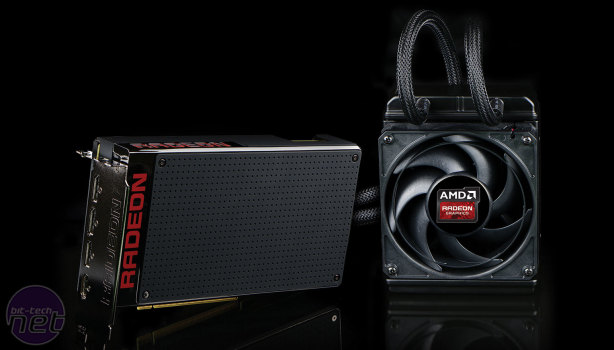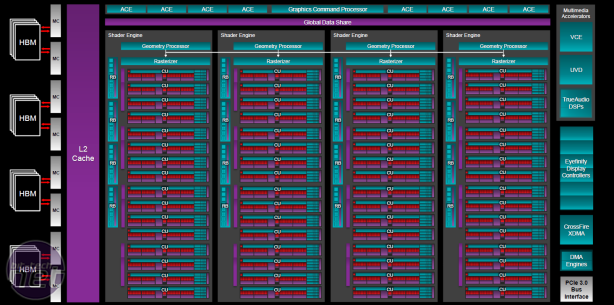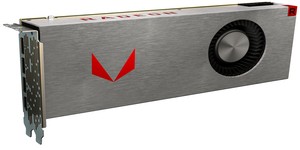
AMD Radeon R9 Fury X Review
Manufacturer: AMDUK price (as reviewed): Approx. £510 (inc VAT)
US price (as reviewed): MSRP $649 (ex Tax)
With it having been almost two years since a new flagship graphics card from AMD, and with Nvidia having launched both the GTX Titan X and GTX 980 Ti in the last few months, it was only a matter of time before AMD responded. Today, it's doing exactly that with the Radeon R9 Fury X. With a brand-new GPU, an entirely new memory system and an onboard liquid cooler, there's plenty to discuss, so without further ado...
The R9 Fury X uses the new AMD Fiji GPU, which bears a similar relationship to the R9 290X's Hawaii chip as the GM200 (used in GTX Titan X and GTX 980 Ti) does to the GM204 (GTX 980) in that the underlying architecture and layout is very familiar; there's just more of it. What this means is that Fiji uses AMD's latest Graphics Core Next architecture. As with Hawaii, there's a single main Graphics Command Processor and eight Asynchronous Compute Engines (ACEs) at the front end for dividing up work, which is split again between four Shader Engines, each with its own geometry processor and rasteriser. For Fiji, however, the Compute Unit count has been increased from 11 per Shader Engine to 16, for a total of 64. Remember, each Compute Unit contains four SIMD engines, which in turn have four texture units and 16 processors each, taking these totals to 256 to 4,096; a theoretical 45 percent increase in raw processing power. That said, the Render Back-End units have remained at 16 (four per Shader Engine), which keeps the ROP count at 64 compared to 96 on the GTX 980 Ti. The L2 cache jumps up to 2MB, as well. The card is clocked at up to 1,050MHz (it will stay at this speed provided it's within its thermal, power and fan speed limits).
The more interesting change with Fiji is a move to High Bandwidth Memory (HBM) from GDDR5. If you want more detail on HBM and why it's being moved to, you can read our in-depth article here. Essentially, however, HBM allows for the stacking of individual DRAM dies, much closer proximity between the GPU and DRAM and a much wider interface. The result is significantly lowered power consumption and space requirements and much higher memory bandwidth.
In its present form, HBM is limited to 1GB per DRAM stack, which limits Fiji, with its four stacks, to 4GB. This is the same as the R9 290X and 2GB less than the GTX 980 Ti, but AMD is confident that this will not limit Fury X, even at 4K with high details. In fact, it is this resolution the card is specifically designed for. With a massive 4096-bit-wide interface achieved through eight 512-bit memory controllers (two per HBM stack) and a 1Gbps effective speed (500MHz clock with double data rate), the Fury X has a total available memory bandwidth of 512GB/sec. This truly is massive; 60 percent over the R9 290X and 52 percent over the GTX 980 Ti. It's also said to offer four times the bandwidth per watt of the R9 290X thanks to the efficiency gains.
As expected, Fury X supports CrossFire XDMA, which enables bridge-less CrossFire set-ups – it's all handled over the PCI-E 3.0 bus. Fury X is also a TrueAudio-enabled GPU.
The added processing power has increased the transistor count to 8.9 billion and the die size to a hefty 596mm2 – it's built on the same 28nm TSMC process. Despite this, the PCB is much smaller than the R9 290X – down from almost 11.5in to 7.5in. This has been achieved first through a roughly threefold reduction in PCB footprint for the GPU and memory, since with HBM they are now placed on the same ASIC, which is 1,011mm2 in this instance. Second, the new liquid cooling solution removes the need for a bulky, long cooler atop the core hardware.
| AMD Radeon R9 Fury X 4GB | AMD Radeon R9 390X 8GB | AMD Radeon R9 290X 4GB | |
| GPU | |||
| Architecture | Graphics Core Next | Graphics Core Next | Graphics Core Next |
| Codename | Fiji | Hawaii XT | Hawaii XT |
| Core Clock | Up to 1,050MHz | Up to 1,050MHz | Up to 1GHz |
| Stream Processors | 4,096 | 2,816 | 2,816 |
| Layout | 4 SEs, 64 CUs | 4 SEs, 44CUs | 4 SEs, 44CUs |
| Texture Units | 256 | 176 | 176 |
| Rasterisers | 4 | 4 | 4 |
| Tesselation Units | 4 | 4 | 4 |
| ROPs | 64 | 64 | 64 |
| Transistors | 8.9 billion | 6.2 billion | 6.2 billion |
| Die Size | 596mm2 | 438mm2 | 438mm2 |
| Process Node | 28nm | 28nm | 28nm |
| Memory | |||
| Amount | 4GB HBM | 8GB GDDR5 | 4GB GDDR5 |
| Frequency | 500MHz (1GHz effective) | 1.5GHz (6GHz effective) | 1.25GHz (5GHz effective) |
| Interface | 4,096-bit | 512-bit | 512-bit |
| Bandwidth | 512GB/sec | 384GB/sec | 320GB/sec |
| Card Specifications | |||
| Power Connectors | 2 x 8-pin | 1 x 8-pin, 1 x 6-pin | 1 x 8-pin, 1 x 6-pin |
| Stock Card Length | 195mm | N/A | 278mm |
| TDP | 275W | 275W | 275W |
In terms of APIs, the R9 Fury X supports DirectX 12, as well as Vulcan and Mantle. AMD dodged the question on the exact DX12 feature level, but we do know that Tiled Resources are supported, suggesting feature level 12_0, compared to 12_1 for the GTX 980 Ti. AMD did draw attention to three key features of DirectX 12, however. First, Async Shaders, which allows work to be broken up into smaller tasks that can be processed at the same time. This will be managed by the dedicated ACE units, and is particularly useful for applying certain compute-based postprocessing effects with minimum impact on performance. DirectX 12 also has native multi-GPU support for the first time, enabling split-frame rendering for lower latency as well as combined, rather than mirrored, memory pools. Finally, there are also big improvements to efficiency when using multi-core CPUs – something that is practically universal now.
Other features include Virtual Super Resolution, a game-agnostic means of achieving supersampling anti-aliasing (SSAA) for the whole image. This is similar to Nvidia's Dynamic Super Resolution, allowing games to be rendered at a higher resolution than a panel's maximum, before being scaled down again to achieve greater detail and smooth edges. There is also Frame Rate Target Control, where you can limit the frame rate in DirectX 10 or 11 games to between 55 and 95fps for power, heat and noise savings. This is being introduced to the whole R9 300 series range; it's not really relevant for a super-high-end, liquid-cooled card like Fury X.
One final word concerns FreeSync. It has previously been criticised for having a lower refresh rate limit of 40Hz, meaning if you drop below 40fps you lose the smoothness. However, we're starting to see this change with the introduction of new screens, three of which are of note: the Asus MG279Q (27in IPS, 1440p, 35-90Hz dynamic refresh rate range), the Acer XR341CK (34in curved IPS, 3,440 x 1,440 UltraWide, 30-75Hz) and the Nixeus NX-VUE24 (24in TN, 1080p, 30-144Hz). The fact that FreeSync can work down to 30Hz is good news – it may not work below this, but 30fps should be your minimum target in games anyway.

MSI MPG Velox 100R Chassis Review
October 14 2021 | 15:04












Want to comment? Please log in.